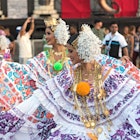
Learn about Panama's Indigenous people and cultures on this new circuit

Oct 14, 2020 • 2 min read

The new program was announced on the International Day of Indigenous Peoples © Panama Tourism Authority (ATP)
Panama is developing a new sustainable tourism circuit that, once approved, will celebrate the unique cultural and natural heritages of its Indigenous peoples.
Panama Indígena, or Indigenous Panama, will shine a light on the country’s pre-Columbian cultures as well as its seven living Indigenous peoples – Bribrí, Naso Tjerdi, Ngäbé, Buglé, Guna, Wounaan and Emberá – emphasizing sustainability along with elements like dance, music, handicrafts, traditional medicine, gastronomy, ecological hiking, and site museums. Developed by the Panama Tourism Authority in conjunction with the National Chamber of Indigenous Tourism, the proposed circuit is part of an overall strategy to introduce visitors to Panama’s storied history.
Tourists from all countries can visit Panama from October
Beginning with pre-Columbian burial sites and the El Caño archaeological park and encompassing wildlife-watching in the jungles of Darién, raft rides through the Panama Canal Watershed, leatherback-turtle preservation initiatives, visits to cacao farms and coffee plantations, and participation in mangrove reforestation projects, plus birdwatching, waterfall hikes, ethnobotany, basket-weaving, interpretive hiking trails, and the annual Indigenous Ancestral Games, this array of diverse experiences will focus on the ecological riches of the Panama Canal basin and the Caribbean beaches of the archipelago of Guna Yala (San Blas) – all with the buy-in of the communities involved.

“We believe that the Indigenous Panama tourism circuit can have a great positive impact on the livelihood of our Indigenous peoples, not only because of the attractiveness of their living millenary traditions but also of the pristine nature that they preserve,” Panama’s minister of tourism, Ivan Eskildsen, tells Lonely Planet. “The plan prioritizes communities that, paradoxically, have economic poverty together with a rich natural and cultural heritage; it is a great opportunity for sustainable economic development to leave no one behind.”
Workshops for governance, product development, branding, marketing, and overall strategy are slated to take place in the coming months, and training programs will outline best practices for hospitality and customer service, instruction in languages and storytelling, sustainable procedures for fair trade, waste management, and efficient clean energy, and more.
“The members of the communities must understand the importance of preserving their traditions, as this will become an additional source of income, but it must remain authentic to be sustainable in the future,” Eskildsen says. “Our goal is to help these communities improve their existing touristic products, always keeping in mind the importance of the preservation of their heritage.” For more information, go to visitpanama.com.
You may also like:
Tips for exploring Panama's Guna Yala territory
Toes in sand, drink in hand: a guide to Panama's islands
Stay and work off-grid at an eco-hotel in Panama
Explore related stories

Art and Culture
Panama City’s 5 best museums (and 6 best art galleries) offer a deeper understanding of the Central American destinationAug 10, 2022 • 6 min read

 BeachesCosta Rica vs Panama: which of these Central American gems is right for you?
BeachesCosta Rica vs Panama: which of these Central American gems is right for you?Jun 4, 2024 • 7 min read



 PhotographyI've visited more than 70 Unesco World Heritage sites - these are my top choices
PhotographyI've visited more than 70 Unesco World Heritage sites - these are my top choicesApr 7, 2022 • 6 min read
 Art and CultureHow salsa, bomba and reggaeton shaped Puerto Rico's culture – and where to hear them
Art and CultureHow salsa, bomba and reggaeton shaped Puerto Rico's culture – and where to hear themJan 10, 2022 • 11 min read
 HistoryXs or Os? Gatekeeping language is a distraction, however you spell “Latinx”
HistoryXs or Os? Gatekeeping language is a distraction, however you spell “Latinx”Nov 25, 2020 • 6 min read
 Digital NomadSee the incredible photos of remote African tribes captured by a COVID frontline nurse
Digital NomadSee the incredible photos of remote African tribes captured by a COVID frontline nurseAug 4, 2020 • 4 min read
